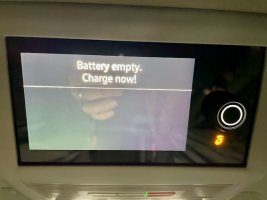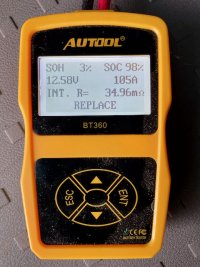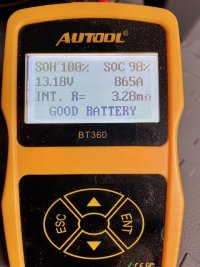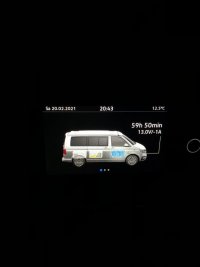Rololux
VIP Member
I know there are various threads on similar topics, but I have not found any mention of this for a 6.1. My leisure batteries are not charging when on EHU, although they do charge when driving. The original symptom was that the parking heater would not start, even though the control panel indicated that there was >63hrs charge remaining. However, had red triangle indicator on the battery indicator, and only 1 or 2 bars shown, so batteries did appear to be low. Connected EHU, and heater functioned as normal. Initially, 9A charging was shown, but this quickly began to go down, and reached 0A in a couple of minutes. I then unplugged the EHU, and the charge remaining then started falling very fast, eventually settling down at 1hr20 mins! Reconnecting EHU after 30 mins or so and it showed 2A charging, again reducing to 0A in a few seconds.
Went for a short drive - just 10km or so, and when I returned charge remaining had risen to about 30 hrs, and 4 bars on battery indicator, so batteries are charging when driving.
I cannot be sure that charging on EHU has ever worked, as I've only had the van a few months, and hardly used it, due to the restrictions. I've never checked the charging rate, just noticed that the EHU charging light is always on when EHU connected. I have not actually driven it for about three weeks, so this may explain why batteries have drained a bit, but nothing has been connected and nothing turned on, so this would indicate that the batteries were pretty low to start with.
I'll be taking it in to the dealer when possible, but in the meantime, has anyone experienced anything similar, or can anyone suggest what is going on? The strange thing to me is that it did initially shown charge was getting to the batteries, so it's not as simple as a plug somewhere is disconnected.
Thanks in advance.
Went for a short drive - just 10km or so, and when I returned charge remaining had risen to about 30 hrs, and 4 bars on battery indicator, so batteries are charging when driving.
I cannot be sure that charging on EHU has ever worked, as I've only had the van a few months, and hardly used it, due to the restrictions. I've never checked the charging rate, just noticed that the EHU charging light is always on when EHU connected. I have not actually driven it for about three weeks, so this may explain why batteries have drained a bit, but nothing has been connected and nothing turned on, so this would indicate that the batteries were pretty low to start with.
I'll be taking it in to the dealer when possible, but in the meantime, has anyone experienced anything similar, or can anyone suggest what is going on? The strange thing to me is that it did initially shown charge was getting to the batteries, so it's not as simple as a plug somewhere is disconnected.
Thanks in advance.


















